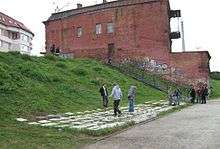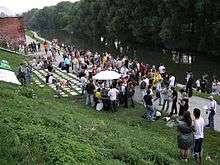Keyboard Monument
Keyboard Monument (Russian: Памятник клавиатуре) is an outdoor sculpture featuring the QWERTY/JCUKEN keyboard. It is located in the Russian city of Yekaterinburg alternatively spelt Ekaterinburg and is popular among tourists.[1][2]

History
It was created by Anatoly Vyatkin and installed on October 5, 2005 on the embankment of the Iset River in the city centre.[2][3]
The landmark depicts an IBM PC compatible Cyrillic computer keyboard at 30:1 scale (the area covered by the monument is 16 × 4 m), with 104 concrete keys. Each regular key weighs 180 pounds, while the space bar alone weighs 1,000 pounds.[4]
The keyboard attracts many visitors to the city and is today considered one of its top sights. It is also referred to as "one of the miracles of Russia" by some researchers.[5] Niklaus Wirth, Pascal programming language designer, evaluated the object while it was being constructed and found it to be fascinating.[6]
Keys F1, F2, F3, and Y were once stolen and in 2011 were rebuilt.[7]
In 2019 a survey by national search engine Yandex found that Keyboard Monument was the 2nd most searched monument among all of Russia's numerous famous monuments. The 1st position was held by Bronze Horseman the 3rd Monument to Minin and Pozharsky.[8]

In May 2019 it became known that the monument is facing threat of demolition. The nearby stairway was destroyed[9].
Events
Regular celebrations are held near the object. Among them the annual internationally recognised Sysadmin Day on the last Friday in July. Before 2010 Ekaterinburg technicians were gathering at separate places, and since 2010 Ekaterinburg authorities granted official permission for the event to be held near the Keyboard Monument with support from IT companies.[10] There are "sysadmin competitions" between participants: they throw defunct PC mice to reach maximum distance and also throw such mice (with their "tails" cut out) within an empty distant computer case used as basket. Additionally, they powerlift a bundle of unused HDDs.[11] In 2016 during such an event a memorial plaque was set up at the monument to honour Eugene Zorin, the Ekaterinburg FidoNet organiser and Internet pioneer who died recently.[12] In the end of April, the "Keyboard Subbotniks" are also held, when people are cleaning and re-painting the monument, and "sports competitions" also take place. Two volunteers from the USA took part in the procedure in 2017, local press reports[13].
References
- https://www.nytimes.com/2018/07/03/sports/world-cup/yekaterinburg-keyboard-monument.html
- "Keyboard Monument". English Russia. 2006-10-09. Retrieved 2011-08-23.
- Jessica Patterson (2011-02-13). "Walk the Keyboard: Russian QWERTY Keyboard Stones Monument | Design Blog". design.org. Archived from the original on 2013-03-25. Retrieved 2011-08-23.
- "Russian IT Pros Decide The Fate Of Keyboard Monument". publiciti.ru. 2011-04-25. Archived from the original on 2011-08-11. Retrieved 2011-08-23.
- (in Russian) http://www.ruschudo.ru/miracles/356.html
- (in Russian) http://art.1001chudo.ru/russia_583.html
- "Keyboard Monument". ulc-russia.com. 2014-03-24. Retrieved 2014-03-24.
- https://www.facebook.com/minkultrf/posts/2064972870253226
- https://www.facebook.com/groups/ekbkeyboard/permalink/2192473447496774/
- (in Russian) http://www.e1.ru/news/spool/news_id-331716.html
- (in Russian) http://www.ural.kp.ru/photo/66600/
- (in Russian) n:ru:Память уральского общественника Евгения Зорина увековечили на одной из клавиш Памятника клавиатуре
- (in Russian) http://www.e1.ru/news/spool/news_id-469510.html
| Wikimedia Commons has media related to Keyboard monument, Yekaterinburg. |